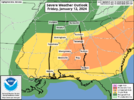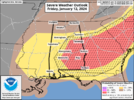Darklordsuperstorm
Member
That would be some low-topped convection by looking at that sounding.
Yes for NC SC. This one's got big ticket potential to our west imoFox Carolina said it's gonna be "much weaker" and "nothing close" to the system today.


Dryline in jan. Gotta love it. We can’t snow but we sure are good at severeSPC still mentioning a lot of uncertainty for this one. Looks like it has a pretty high ceiling. Still some uncertainty especially with regards to instability. Seems like a lot if the current data is pointing to the possibility of the warm moist air at the surface not being in sync with the area of coldest air aloft. Going to be interesting to see what the mesoscale models start showing today.
Snippet of SPC outlook:
There remains some uncertainty just how expansive of an unstable
warm sector may develop, with perhaps low-level warming and
moistening becoming sufficient for weak boundary-layer
destabilization northeast of the lower Mississippi Valley through
parts of the Tennessee and lower Ohio Valleys during the day.
More substantive low-level moistening seems probable off the north
central/northeastern Gulf of Mexico, into the eastern Gulf through
southern Atlantic Coast states. It appears that this may remain
south of the mid-level cold pool, with relatively warm layers aloft,
even in advance of mid-level subsidence warming nosing
east-northeastward across coastal areas, possibly inhibiting
destabilization.
However, strong to severe thunderstorm development initiating
Thursday night across the southeastern Great Plains into lower
Mississippi Valley may spread east/northeast of the Mississippi
River Friday morning, before perhaps weakening. Thereafter, it
appears that a corridor of stronger surface pressure falls will
develop near the Southeastern Piedmont, from Alabama through the
Carolinas, Friday afternoon into Friday evening. Near the southern
periphery of the mid-level height falls, this might become the
primary focus for organized storm development. Otherwise, models
suggest that a pre-frontal dryline structure may develop across east
central/southeastern Alabama during the mid to late afternoon,
before surging across central Georgia into the Carolinas by late
Friday evening.
Although storm mode remains uncertain, there is concern that this
environment may support and maintain discrete supercell development
with a risk for strong tornadoes. Otherwise, the evolution of at
least a small organized cluster might also be possible, accompanied
by potential for very strong and damaging convective gusts.
New risk areas and probs:View attachment 141092View attachment 141093
Brick?Dryline in jan. Gotta love it. We can’t snow but we sure are good at severe
Tell me about it.Dryline in jan. Gotta love it. We can’t snow but we sure are good at severe
